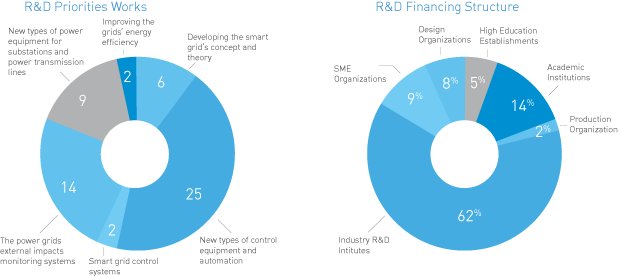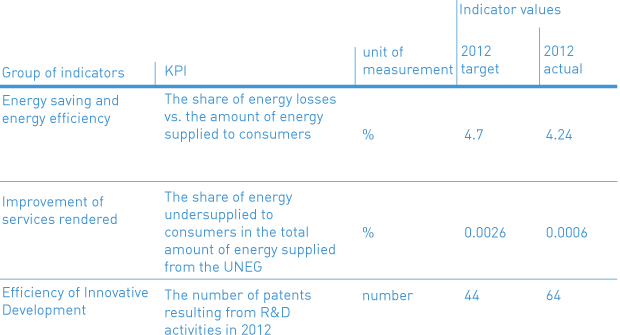- Statement of the Chairman of the Management Board
- Federal Grid Company General Information
- Corporate Governance
- Internal Control System
- The Risk Management System
- Understanding of Corporate Social Responsibility and Sustainable Development
- Human Resources Management
- Managing of the Economic Impact
-
Anti-corruption and Prevention of Conflict of Interests System
- JSC Federal Grid Company`s Anti-Corruption Policy
- Program for Prevention of Corruption and Settlement of Conflict of Interests in Federal Grid Company for 2012-2014
- Implementation of Anti-Corruption Policy and Program for Anti-corruption and Settlement of Conflict of Interests in Federal Grid Company in 2012
- 2013 Plans
- Environmental Impact Management
- Stakeholders Relations
-
APPENDICES
- The UNEG Reliability Provisions
- Innovative Development of the UNEG
- GRI Guidelines Indicators (G 3.1 and the Industry Protocol for Electric Power Industry), Reflected in the Report
- A Report on the Fulfillment of the 2012 CSR Plans and Obligations of JSC FGC UES (Draft)
- A Table of Stakeholders’ Suggestions Pertaining to the Disclosure of Information in the Report, Voiced at the Dialogue on 05.04.2013 and at the Public Hearings on 26.04.2013
- A List of Natural Areas in Preferential Protection (NAPP) Accessible for JSC FGC UES for the Purposes of Operation
- Independent Assurance of Social Reporting
- Glossary and Abbreviations
Innovative Development of the UNEG
The Innovative Development Program
The goal of the UNEG innovative development consists in the establishment of an Intellectual Energy System with an Active-Adaptive Grid (IES AAG) or Smart Grid. The achievement of this goal involves a transfer to the new quality grids based on the use of new principles and processes of energy transmission and transformation. This approach forms a part of the Innovative Development Program of Federal Grid Company for the period till 2016*.
The Program priorities include the development, testing and implementation of the “breakthrough” and the “improvement” technologies at the UNEG facilities. The processes include electric energy storage, high temperature superconductivity, direct current energy transmission and other innovations. The Program is also intended to encourage the Company’s system of innovative activities, including the expansion of the Company’s research and engineering basis in Russia, attracting foreign partners, and the cooperation with Russian academic and higher education establishments.
Federal Grid Company launched the establishment of the active-adaptive electric power grid in 2010. The active-adaptive electric power grid implies the unification of the power grids, the consumers and the producers of electric energy in a unified automated system. Today the innovative processes and solutions are tested in real time at the existing power grid facilities. The next stage is the establishment of energy clusters used to test the solutions and the element base of the intellectual grid (identification of cons and pros, and of synergy effects from the use of different processes) for further multiplication of these technologies within the UES of Russia.
* Federal Grid Company’s Innovative Development Program till 2016 with the view till 2020 was approved on April 7, 2011 by the Company’s Board of Directors (Minutes No 128, dated 07.04.2011). The Program is based on the Company’s Policy for Innovative Development and Modernization and on the Concept (principal provisions) of the Innovative Development Program, approved by the Company’s Board of Directors (Minutes No 120, dated 16.12.2010).
2013-2017 Research and Development (R&D) Program and related financing costs
Pursuant to the Innovative Development Program the Company suggested to higher education establishments, research and development institutes, the design, production and other industry organizations to participate in the formation of the Company’s R&D Program for 2013-2017.
Pursuant to the Company’s 2013-2017 Investment Program the financing for the 2013-2017 R&D Program of Federal Grid Company* (hereinafter called the R&D Program) in 2012 comprised RUR 3,100 million. The Company spent RUR 2,913.99 million (or 94% of the planned amount in 2012 and 153.5% compared to 2011).
R&D Program Financing, RUR billion
* The Program was approved by the Order No 564 “On the Approval of the 2013-2017 R&D Program of JSC FGC UES” of the Company

The Company’s Innovative Development Program sets the goals for R&D priorities to be achieved in 2020. The goals to be achieved by 2020 include the following:
- — theoretical concepts, models and programs forming the basis of the Smart Grid;
- — new types of power equipment for electric power grids, including SF6 insulated switchgear for digital substations, controlled shunt reactors and devices based on high-temperature superconductivity (HTSC), vacuum triggered spark gaps, the grid power storage devices based on accumulators and super capacitors. All equipment should be systematically tested;
- — new types of control equipment and automation, protection and metering systems for the Smart Grid, including the Parametric Measurement Units (PMU), the complex systems for the relay and emergency protection automation and the concept for the development and application of the systems of relay protection and automation for the Smart Grid;
- — the equipment and theoretical foundations for the Smart Grid control systems, including a pilot Digital Substation test field, the systems for the acquisition and transfer of data and the UNEG condition monitoring system, a general information model of the UES based on MEC standards, a set of programs for the automated control of the Smart Grid, the Smart Grid’s architecture and the structure of the unified process control system;
- — the experimental prototypes of equipment and systems for the protection of overhead power transmission lines from the external impacts (thunderstorm, ice, pollutions), including high composite towers, ice-resistant nano-composite wires, automatic remote system for direction finding and monitoring of lightning discharge impacting the overhead power transmission lines, the combined installations for ice melting and reactive power compensation, etc.
- — the technical solutions pertaining to the improvement of reliability of the power transmission along the UNEG grids, including the classifier, breaking down the consumers into the levels of reliability required, the calculation of the numeric indicators of the reliability of consumers of the electric power transmission services rendered by Federal Grid Company;
- — the technical solutions and electric equipment to reduce the losses of energy within the UNEG grids.
The Innovative Development results
Key Performance Indicators of the Program, Describing the Results of the 2012 Innovative Development

In 2012 the Company implemented certain elements of the intellectual grid and other innovative solutions at the facilities of Federal Grid Company. An experimental prototype of the system for continuous monitoring of the transformer overload capacity was commissioned at 500 kV SS Noginsk.
The system makes it possible to use automated calculation methods which take into account the latest developments in the field of control over the thermal condition of transformers at low-maintenance 110-750 kV substations. The implementation of the system will contribute to the establishment of fully automatic maintenance-free substations. This is a typical example of the Company’s innovative developments with the end results achieved.
The MES Center, a branch of the Company equipped the underground power supply substations of Skolkovo Innovations Center with the newest gas-insulated automatic power transformers. This was the first time such automatic transformers were used at substations operated in urban areas. Compared with the traditional oil-insulated automatic transformers, gas-insulated automatic transformers have a number of advantages. These transformers are completely safe (as they are explosion and fire safe), with sulfur hexafluoride being used as insulating and cooling agent. No less important is an efficient compatibility of such automatic transformers with gas-insulated switchgear, which provides for the compact substation layout. This innovative solution will reduce the cost of construction of the closed-type electric power facilities in urban areas.
The MES Ural, a branch of the Company implemented the newest technology for the strengthening of foundations of 220-500 kV power transmission line towers, using high-strength carbon fiber. The carbon fiber strengthening restores the carrying capacity of the structure completely, blocking the processes damaging the towers. This polymeric material is highly resistant to earthquakes. It is also resistant to chemicals and raptures – the fiber is stronger than metal. Besides, the simplicity of use of carbon fiber reduces repair times, cutting down the repair costs. This new method has been developed by the Yekaterinburg Institute for High-Strength Reinforcement Systems NII VSU INTER/TEK.
The innovations most popular with the Company include suspended polymeric insulators which is far better compared with the traditional porcelain insulators. The polymeric insulators are more hydrophobic, which is important for highly salted territories, such as Perm and Solikamsk. The insulators are also resistant to mechanical and electric loads, while being durable in operation.
Other innovative equipment includes STC-1, a static thyristor compensator of reactive power, an essential element for the establishment of a new generation main power transmission grid.
The towers of new generation high-voltage power transmission lines are made of steel many-sided stands, which are highly reliable and durable. The stands are resistant to ice and wind loads, and corrosion effects. The stands are quick to assemble and install.
The expert assessment of the Innovative Developments
Federal Grid Company is one of the leading companies in the Innovative Development Rating prepared by Expert RA rating agency for state corporations and companies with governmental participation. In the opinion of the authors of the rating, the energy companies are more motivated to develop their competitive advantages, in order to develop their business abroad.
In the result, the R&D costs borne by the Russian energy companies are comparable and even exceed those borne by their foreign competitors (FGC UES- 2.64%, Edf – 0.7% and National Grid – 0.1%). The authors of the survey also note that the innovative development program of Federal Grid Company contains a number of breakthrough projects pertaining to the establishment of the intellectual energy system based on the active-adaptive grid. No high and super-high voltage mains can boast such technologies even at the design stage, except those owned by Federal Grid Company.

 square km
square km